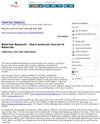人工神经网络模拟在钛基复合材料磨损率和摩擦系数预测中的应用
IF 1.5
4区 材料科学
Q4 MATERIALS SCIENCE, MULTIDISCIPLINARY
Materials Research-ibero-american Journal of Materials
Pub Date : 2023-03-31
DOI:10.1590/1980-5373-mr-2022-0306
引用次数: 1
摘要
本文章由计算机程序翻译,如有差异,请以英文原文为准。
Applications of Artificial Neural Network Simulation for Prediction of Wear Rate and Coefficient of Friction Titanium Matrix Composites
The Artificial Neural Network (ANN) techniques were utilized to predict wear rate and CoF of the Ti-5Al-2.5Sn matrix reinforced with B 4 C particle manufactured by the powder metallurgy. TMCs and wear test samples were characterized by the Scanning Electron Microscope (SEM). Dry sliding wear narrative of the composites was estimated on a pin-on-disc machine at various loads of 20-60N, sliding velocity of 2-6m/s and sliding distance from 1000m-3000m. The wear rate of the composite was reduced by augmentation in weight fraction of boron carbide from 3-9%. The benefits of interfacial TMCs with B 4 C are: increase in strength, wear-resistance, and volume fraction. ANN was planned and utilizes a Levenburg-Marquardt program algorithm to reduce the mean squared error using a back-propagation technique. The input parameters are considered to include load, sliding velocity, and sliding distance. The experimental results of an ANN model and regression model are compared. ANN replicas have been urbanized to foreshow experimental rate of wear and CoF of TMCs and examined that ANN predictions have exceptional concord with deliberated values. Accordingly, the prediction of wear rate and CoF of TMCs using ANN in earlier actual manufacture will significantly save the manufacturing time, exertion, and expenditure.
求助全文
通过发布文献求助,成功后即可免费获取论文全文。
去求助
来源期刊

Materials Research-ibero-american Journal of Materials
MATERIALS SCIENCE, MULTIDISCIPLINARY-
CiteScore
2.40
自引率
11.80%
发文量
161
审稿时长
3 months
期刊介绍:
Information not localized
 求助内容:
求助内容: 应助结果提醒方式:
应助结果提醒方式:


